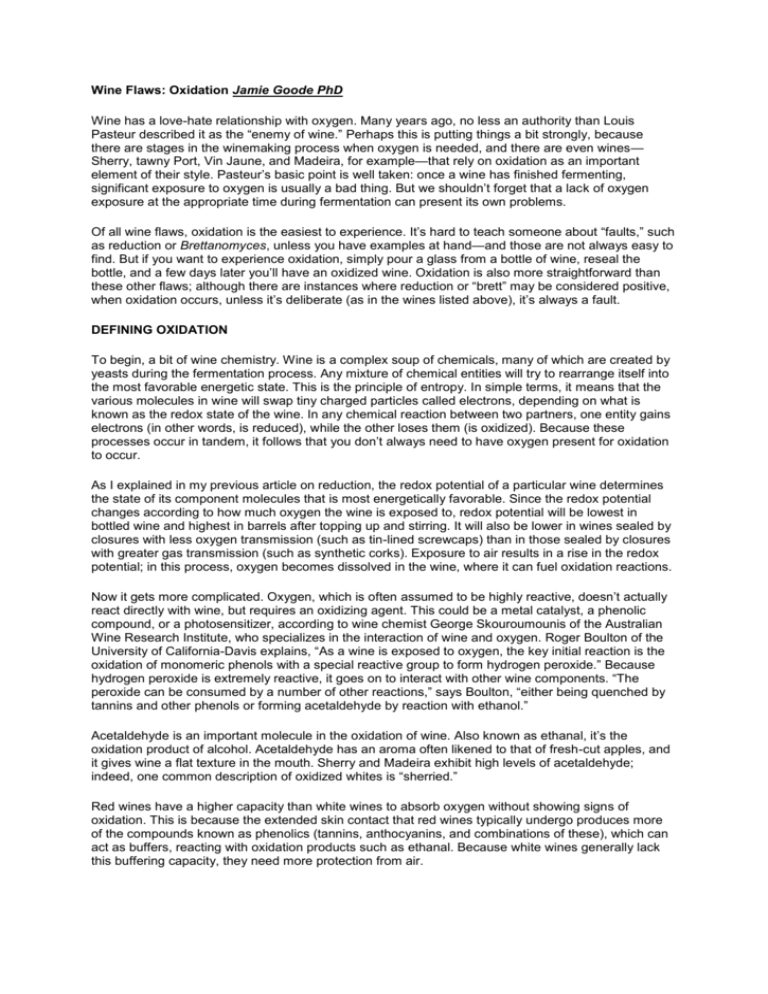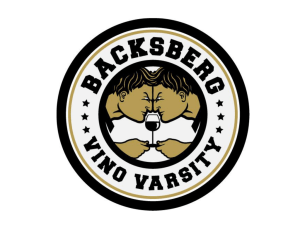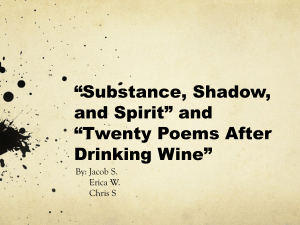Wine Flaws: Oxidation Jamie Goode PhD
advertisement

Wine Flaws: Oxidation Jamie Goode PhD Wine has a love-hate relationship with oxygen. Many years ago, no less an authority than Louis Pasteur described it as the “enemy of wine.” Perhaps this is putting things a bit strongly, because there are stages in the winemaking process when oxygen is needed, and there are even wines— Sherry, tawny Port, Vin Jaune, and Madeira, for example—that rely on oxidation as an important element of their style. Pasteur’s basic point is well taken: once a wine has finished fermenting, significant exposure to oxygen is usually a bad thing. But we shouldn’t forget that a lack of oxygen exposure at the appropriate time during fermentation can present its own problems. Of all wine flaws, oxidation is the easiest to experience. It’s hard to teach someone about “faults,” such as reduction or Brettanomyces, unless you have examples at hand—and those are not always easy to find. But if you want to experience oxidation, simply pour a glass from a bottle of wine, reseal the bottle, and a few days later you’ll have an oxidized wine. Oxidation is also more straightforward than these other flaws; although there are instances where reduction or “brett” may be considered positive, when oxidation occurs, unless it’s deliberate (as in the wines listed above), it’s always a fault. DEFINING OXIDATION To begin, a bit of wine chemistry. Wine is a complex soup of chemicals, many of which are created by yeasts during the fermentation process. Any mixture of chemical entities will try to rearrange itself into the most favorable energetic state. This is the principle of entropy. In simple terms, it means that the various molecules in wine will swap tiny charged particles called electrons, depending on what is known as the redox state of the wine. In any chemical reaction between two partners, one entity gains electrons (in other words, is reduced), while the other loses them (is oxidized). Because these processes occur in tandem, it follows that you don’t always need to have oxygen present for oxidation to occur. As I explained in my previous article on reduction, the redox potential of a particular wine determines the state of its component molecules that is most energetically favorable. Since the redox potential changes according to how much oxygen the wine is exposed to, redox potential will be lowest in bottled wine and highest in barrels after topping up and stirring. It will also be lower in wines sealed by closures with less oxygen transmission (such as tin-lined screwcaps) than in those sealed by closures with greater gas transmission (such as synthetic corks). Exposure to air results in a rise in the redox potential; in this process, oxygen becomes dissolved in the wine, where it can fuel oxidation reactions. Now it gets more complicated. Oxygen, which is often assumed to be highly reactive, doesn’t actually react directly with wine, but requires an oxidizing agent. This could be a metal catalyst, a phenolic compound, or a photosensitizer, according to wine chemist George Skouroumounis of the Australian Wine Research Institute, who specializes in the interaction of wine and oxygen. Roger Boulton of the University of California-Davis explains, “As a wine is exposed to oxygen, the key initial reaction is the oxidation of monomeric phenols with a special reactive group to form hydrogen peroxide.” Because hydrogen peroxide is extremely reactive, it goes on to interact with other wine components. “The peroxide can be consumed by a number of other reactions,” says Boulton, “either being quenched by tannins and other phenols or forming acetaldehyde by reaction with ethanol.” Acetaldehyde is an important molecule in the oxidation of wine. Also known as ethanal, it’s the oxidation product of alcohol. Acetaldehyde has an aroma often likened to that of fresh-cut apples, and it gives wine a flat texture in the mouth. Sherry and Madeira exhibit high levels of acetaldehyde; indeed, one common description of oxidized whites is “sherried.” Red wines have a higher capacity than white wines to absorb oxygen without showing signs of oxidation. This is because the extended skin contact that red wines typically undergo produces more of the compounds known as phenolics (tannins, anthocyanins, and combinations of these), which can act as buffers, reacting with oxidation products such as ethanal. Because white wines generally lack this buffering capacity, they need more protection from air. What about sulfur dioxide? The simple answer is that sulfur dioxide, which is added to almost all wines as a preservative, protects wine from oxidation. White wines are typically bottled with at least 30 mg/l of free sulfur dioxide, but this level declines over time. When it drops below about 10 mg/l, the wine begins to show signs of oxidation. But the science is a bit more complex than that. “There is a general misconception that sulfur dioxide will protect against oxidation,” says Boulton. “Its rate of reaction with oxygen is so slow that it cannot compete for the oxygen and stop the phenol oxidation. While it does compete for the peroxide formed, its main role is binding up the aldehyde formed, so that we do not smell the oxidation product.” Exposure of the developing wine to oxygen is crucial at certain stages of the process, and getting this right is one of the keys to successful winemaking. The problem is that there’s a lot of guesswork involved. Traditional winemaking practices have serendipitously controlled oxygen exposure by using oak barrels and processes such as racking—often to good effect, sometimes not. One of the successes of modern winemaking has been the use of stainless-steel fermentation tanks and other practices that protect the must and evolving wine from oxygen throughout the winemaking process. This is known as “reductive” winemaking, and it has been central to the development of fruit-driven wine styles. Some winemakers will, however, deliberately expose their white wine musts to oxygen, allowing oxidation of many of the phenolic compounds in what is called “oxidative juice handling.” The must turns dark, but from then on the wine is handled reductively. The resulting white wine is actually longer-lived and more resistant to oxidation. RECOGNIZING OXIDATION Perhaps the easiest way to spot an oxidized wine is by a change in color. The vivid purple, garnet, or cherry-red colors of young wine fade with increasing oxygen exposure, turning a brick-red or even brown hue; whites darken dramatically, eventually taking on a golden-brown color. On the nose, both reds and whites lose their fresh, fruity aromas and become flat. In whites, you can pick out the apple-cider notes of acetaldehyde, and the wine smells like Sherry. Reds smell tired and fruitless, and can sometimes develop a caramelized quality. The palate of oxidized red wine also changes: it tends to take on a dry, slightly bitter character. It is much easier to spot oxidation in young wines than in older ones, and this raises the thorny question of the role of oxidation in wine aging. Conventional wisdom says that wine aging is an anaerobic process that works best in the absence of external oxygen. This hypothesis is backed by anecdotal reports that old wines with the smallest ullages, where the corks have presumably provided the best seals, tend to show the best. Studies in Australia comparing Chardonnay sealed with glass ampules, screwcaps, and natural cork suggest that wines sealed hermetically, with no oxygen ingress, will still develop, but at the cost of some reduction defects. It could be that only a trace of oxygen is needed early in the aging process, to avoid reduction problems, and that the best aging then ensues under the tightest possible seal. The difficulty with serving old wines in restaurants is having to decide when a wine is oxidized to the point of faultiness, and when it is showing signs of oxidation consistent with normal aging. Except in extreme circumstances, this decision is not always clear-cut. STORAGE ISSUES If a wine is truly oxidized, what is the likely cause? There are several possibilities. It could be that the closure has failed, or the wine has been damaged by poor storage conditions, or the bottle has simply been open too long. Heat increases the rate of chemical reactions, including oxidation events. But it also encourages chemical reactions that wouldn’t take place at lower temperatures at all: this is one reason why wines kept at elevated temperatures don’t just age faster, but age worse. Swings in temperature hasten the rate of oxidation, because as the temperature rises and falls, the pressure of the head space above the wine changes, and there is a small exchange of air between the atmosphere and the wine bottle. There is also some evidence that corks in contact with air (in standing bottles) have a higher rate of gas exchange than those where the wine abuts the cork surface, which confirms the wisdom of laying down wine in cellars. A current controversy in the wine world concerns the premature, random oxidation of white Burgundy from the 1995, 1996, and perhaps subsequent vintages. It’s certainly a worrisome phenomenon— customers are finding that even in a case of high-end white Burgundies from the same producer, vineyard, and vintage, some will be pristine, while others will be lifeless, dark, and oxidized. No one knows exactly why, although several theories have been advanced. The random nature of the problem points the finger at cork problems, but it appears likely that some other factor is making the wines excessively fragile, so that the natural variation in cork oxygen transmission is causing some bottles to oxidize prematurely. A limitation of restaurant by-the-glass programs is that a good deal of wine can end up wasted. As soon as a bottle is uncorked and a glass poured, the process of oxidation has begun. A number of preservation systems are available, but it’s questionable whether any of them work better than simply recorking the wine and keeping it in a cool place. One popular option, the Vacu Vin, uses specialized rubber stoppers and a pump to suck air out of the bottle, creating a partial vacuum. In practice, this method is disappointing for two reasons. First, the pump is likely to remove dissolved carbon dioxide and thus strip aromatic components from the wine, affecting its flavor. Second, the wine will have already absorbed oxygen during the process of opening and pouring—enough to cause significant oxidation over the succeeding few days. Another preservation system dispenses an inert gas such as nitrogen into an open wine bottle to expel the air. This procedure has the same drawback, however: the act of pouring will have already introduced oxygen to the wine. The only way to truly preserve the wine is to use an inert gas to dispense the wine in the first place, preventing any oxygen pick-up. Enomatic Wine Serving Systems, which work in this manner, are currently becoming popular because they enable hotels and restaurants to offer even rare wines by the glass. The Cruvinet is a similar device. In conclusion, oxidation is a catastrophic wine fault, but one that—in young wines, at least—is fortunately rare in this age of modern winemaking. Its incidence increases dramatically in older wines, as well as in wines that have been stored improperly. It is also encountered in by-the-glass wine service with low turnover and ineffective control measures. Although the chemistry of the interaction between wine and oxygen is complicated, it is vitally important to the wine professional.





